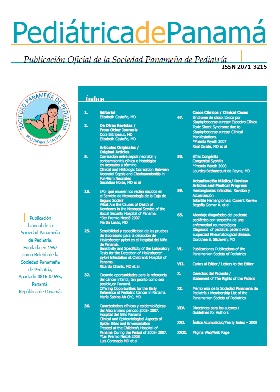Epiema necessitatis: a rare complication of pneumonia. Report of a case
Authors
DOI:
https://doi.org/10.37980/im.journal.rspp.20181610Keywords:
Empyema necessitatis, pleural effusion, thoracic wall massAbstract
Empyema necessitans or necessitatis is a rare complication of untreated or inadequately controlled empyema. It is characterized by the dissection of pus through the soft tissue and the skin of the chest wall. The pus collection breaks and links with the exterior, forming a fistula between the pleural space and the skin.
We present the clinical case of a 3-year-old male patient whose symptoms started a week before his hospitalization with a productive cough, without a predominance of hours, unquantified fever and hyaline rhinorrhea. Subsequently, he developed an increase in volume on the lateral side of the left hemithorax associated with hyporexia and general decline, so the mother consulted, and he was hospitalized. When performing the physical examination, he was in an antalgic position adopting the left lateral decubitus position and with decreased mobility of said hemithorax. He had tachypnea but not intercostal or subcostal drainage. The increase in volume on the lateral side of the left hemithorax was evident with inflammatory signs with erythema, increased temperature and pain. A decrease in respiratory sounds in the left hemithorax was auscultated. On the day of his hospitalization, blood count showed leukocytosis with deviation to the left and elevation of acute phase reactants. Chest X-ray revealed a total left opacity, with effacement of the ipsilateral costodiaphragmatic angle, inflammatory soft tissue amnion of said hemithorax and contralateral mediastinal displacement. Empyema necessitatis was suspected due to clinical data and radiographic findings, and this diagnosis was confirmed by performing an ultrasound and a contrast computed tomography of the thorax. The collection drainage was performed in the thoracic wall and a pleural tube was placed.
In the pleural fluid sample, a Staphylococcus aureus sensitive to oxacillin and clindamycin was isolated, so treatment with these antibiotics was initiated. The patient had a good clinical course and was discharged with follow-up in the outpatient clinic of pulmonology. He went to the control appointment and was asymptomatic with a normal physical examination and no pleuropulmonary alterations were found in the chest X-ray.
Downloads
Published
Issue
Section
License
Copyright (c) 2020 Infomedic InternationalDerechos autoriales y de reproducibilidad. La Revista Pediátrica de Panamá es un ente académico, sin fines de lucro, que forma parte de la Sociedad Panameña de Pediatría. Sus publicaciones son de tipo gratuito, para uso individual y académico. El autor, al publicar en la Revista otorga sus derechos permanente para que su contenido sea editado por la Sociedad y distribuido Infomedic International bajo la Licencia de uso de distribución. Las polítcas de distribución dependerán del tipo de envío seleccionado por el autor.






